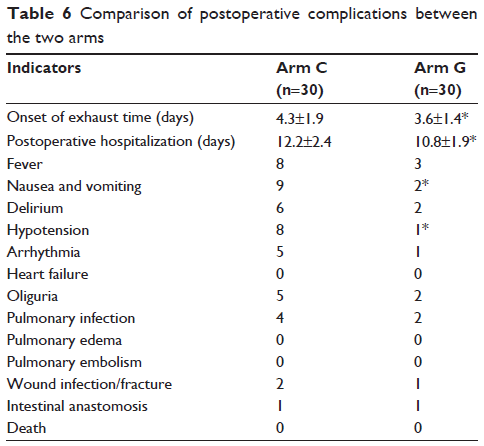108605
论文已发表
注册即可获取德孚的最新动态
IF 收录期刊
- 3.4 Breast Cancer (Dove Med Press)
- 3.2 Clin Epidemiol
- 2.6 Cancer Manag Res
- 2.9 Infect Drug Resist
- 3.7 Clin Interv Aging
- 5.1 Drug Des Dev Ther
- 3.1 Int J Chronic Obstr
- 6.6 Int J Nanomed
- 2.6 Int J Women's Health
- 2.9 Neuropsych Dis Treat
- 2.8 OncoTargets Ther
- 2.0 Patient Prefer Adher
- 2.2 Ther Clin Risk Manag
- 2.5 J Pain Res
- 3.0 Diabet Metab Synd Ob
- 3.2 Psychol Res Behav Ma
- 3.4 Nat Sci Sleep
- 1.8 Pharmgenomics Pers Med
- 2.0 Risk Manag Healthc Policy
- 4.1 J Inflamm Res
- 2.0 Int J Gen Med
- 3.4 J Hepatocell Carcinoma
- 3.0 J Asthma Allergy
- 2.2 Clin Cosmet Investig Dermatol
- 2.4 J Multidiscip Healthc

已发表论文
目标导向液体治疗对高血压和胃癌手术老年患者预后的影响
Authors Zeng K, Li YZ, Liang M, Gao YG, Cai HD, Lin CZ
Published Date October 2014 Volume 2014:8 Pages 2113—2119
DOI http://dx.doi.org/10.2147/DDDT.S66724
Received 23 April 2014, Accepted 5 July 2014, Published 29 October 2014
Purpose: We aimed to investigate the influence of perioperative goal-directed fluid therapy (GDFT) on the prognosis of elderly patients with gastric cancer and hypertension.
Methods: Sixty elderly patients (>60 years old) with primary hypertension who received gastric cancer radical surgery and who were American Society of Anesthesiologists (ASA) class II or III were enrolled in the current study. Selected patients were divided randomly into two arms, comprising a conventional intraoperative fluid management arm (arm C, n=30) and a GDFT arm (arm G, n=30). Patients in arm C were infused with crystalloids or colloids according to the methods of Miller’s Anesthesia (6th edition), while those in arm G were infused with 200 mL hydroxyethyl starch over 15 minutes under the FloTrac/Vigileo monitoring system, with stroke volume variation between 8% and 13%. Hemodynamics and tissue perfusion laboratory indicators in patients were recorded continuously from 30 minutes before the operation to 24 hours after the operation.
Results: Compared with arm C, the average intraoperative intravenous infusion quantity in arm G was significantly reduced (2,732±488 mL versus 3,135±346 mL, P <0.05), whereas average colloid fluid volume was significantly increased (1,235±360 mL versus 760±280 mL, P <0.05). In addition, there were more patients exhibiting intraoperatively and postoperatively stable hemodynamics and less patients with low blood pressure in arm G. Postoperative complications were less frequent, and the time of postoperative hospital stay shorter, in arm G. No significant differences were observed in mortality between the two arms.
Conclusion: Our research showed that GDFT stabilized perioperative hemodynamics and reduced the occurrence of postoperative complications in elderly patients who underwent gastric cancer surgery.
Keywords: stroke volume variation, gastric cancer, the elderly
Methods: Sixty elderly patients (>60 years old) with primary hypertension who received gastric cancer radical surgery and who were American Society of Anesthesiologists (ASA) class II or III were enrolled in the current study. Selected patients were divided randomly into two arms, comprising a conventional intraoperative fluid management arm (arm C, n=30) and a GDFT arm (arm G, n=30). Patients in arm C were infused with crystalloids or colloids according to the methods of Miller’s Anesthesia (6th edition), while those in arm G were infused with 200 mL hydroxyethyl starch over 15 minutes under the FloTrac/Vigileo monitoring system, with stroke volume variation between 8% and 13%. Hemodynamics and tissue perfusion laboratory indicators in patients were recorded continuously from 30 minutes before the operation to 24 hours after the operation.
Results: Compared with arm C, the average intraoperative intravenous infusion quantity in arm G was significantly reduced (2,732±488 mL versus 3,135±346 mL, P <0.05), whereas average colloid fluid volume was significantly increased (1,235±360 mL versus 760±280 mL, P <0.05). In addition, there were more patients exhibiting intraoperatively and postoperatively stable hemodynamics and less patients with low blood pressure in arm G. Postoperative complications were less frequent, and the time of postoperative hospital stay shorter, in arm G. No significant differences were observed in mortality between the two arms.
Conclusion: Our research showed that GDFT stabilized perioperative hemodynamics and reduced the occurrence of postoperative complications in elderly patients who underwent gastric cancer surgery.
Keywords: stroke volume variation, gastric cancer, the elderly
